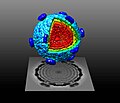Pseudomonas virus phi6
Pseudomonas virus phi6 is a species of bacteriophage that infects Pseudomonas bacteria, specifically targeting the Pseudomonas syringae species. It is a member of the Cystoviridae family and is notable for its unique double-stranded RNA (dsRNA) genome, making it a valuable model organism for studying viral replication, genetic recombination, and RNA interference mechanisms. The virus has a complex structure, with a segmented genome enclosed within a layered capsid, and it employs a lysogenic cycle, integrating its genetic material into the host's DNA.
Structure and Genome[edit]
Pseudomonas virus phi6 possesses a tripartite dsRNA genome, divided into three segments labeled L (large), M (medium), and S (small), each encoding for different viral proteins. The virus's capsid is multilayered, consisting of an outer protein shell and an inner lipid membrane, which is unique among bacteriophages. This complex structure facilitates the virus's ability to protect its RNA from degradation and to inject its genome into host cells efficiently.
Life Cycle[edit]
The life cycle of Pseudomonas virus phi6 begins with the attachment of the virus to the surface of a susceptible Pseudomonas syringae cell. Following attachment, the virus injects its RNA genome into the host cell. Inside the host, the viral RNA is replicated and transcribed to produce viral proteins. New viral particles are assembled within the host cell, eventually leading to the cell's lysis and the release of new virions, which can then infect adjacent cells.
Research and Applications[edit]
Pseudomonas virus phi6 has been extensively studied as a model for understanding the mechanisms of RNA virus replication and evolution. Its ability to undergo genetic recombination and its segmented RNA genome make it an ideal system for studying genetic reassortment, a process similar to that seen in influenza viruses. Additionally, the virus's specificity for Pseudomonas syringae has led to its exploration as a potential biocontrol agent to combat bacterial diseases in agriculture.
Environmental Significance[edit]
The environmental role of Pseudomonas virus phi6 and other bacteriophages is significant, as they contribute to the regulation of bacterial populations in various ecosystems. By infecting and lysing specific bacteria, they can influence microbial community dynamics and nutrient cycling. Their role in controlling populations of Pseudomonas syringae, a plant pathogen, highlights their potential utility in agricultural settings to reduce crop loss and decrease reliance on chemical pesticides.
See Also[edit]
-
RNA packaged procapsid of phi6
-
Pseudomonas_virus_phi6
-
Phi6 virions
-
Pseudomonas_virus_phi6
-
Pseudomonas_virus_phi6
Ad. Transform your life with W8MD's Budget GLP-1 injections from $75


W8MD offers a medical weight loss program to lose weight in Philadelphia. Our physician-supervised medical weight loss provides:
- Weight loss injections in NYC (generic and brand names):
- Zepbound / Mounjaro, Wegovy / Ozempic, Saxenda
- Most insurances accepted or discounted self-pay rates. We will obtain insurance prior authorizations if needed.
- Generic GLP1 weight loss injections from $75 for the starting dose.
- Also offer prescription weight loss medications including Phentermine, Qsymia, Diethylpropion, Contrave etc.
NYC weight loss doctor appointmentsNYC weight loss doctor appointments
Start your NYC weight loss journey today at our NYC medical weight loss and Philadelphia medical weight loss clinics.
- Call 718-946-5500 to lose weight in NYC or for medical weight loss in Philadelphia 215-676-2334.
- Tags:NYC medical weight loss, Philadelphia lose weight Zepbound NYC, Budget GLP1 weight loss injections, Wegovy Philadelphia, Wegovy NYC, Philadelphia medical weight loss, Brookly weight loss and Wegovy NYC
|
WikiMD's Wellness Encyclopedia |
| Let Food Be Thy Medicine Medicine Thy Food - Hippocrates |
Medical Disclaimer: WikiMD is not a substitute for professional medical advice. The information on WikiMD is provided as an information resource only, may be incorrect, outdated or misleading, and is not to be used or relied on for any diagnostic or treatment purposes. Please consult your health care provider before making any healthcare decisions or for guidance about a specific medical condition. WikiMD expressly disclaims responsibility, and shall have no liability, for any damages, loss, injury, or liability whatsoever suffered as a result of your reliance on the information contained in this site. By visiting this site you agree to the foregoing terms and conditions, which may from time to time be changed or supplemented by WikiMD. If you do not agree to the foregoing terms and conditions, you should not enter or use this site. See full disclaimer.
Credits:Most images are courtesy of Wikimedia commons, and templates, categories Wikipedia, licensed under CC BY SA or similar.
Translate this page: - East Asian
中文,
日本,
한국어,
South Asian
हिन्दी,
தமிழ்,
తెలుగు,
Urdu,
ಕನ್ನಡ,
Southeast Asian
Indonesian,
Vietnamese,
Thai,
မြန်မာဘာသာ,
বাংলা
European
español,
Deutsch,
français,
Greek,
português do Brasil,
polski,
română,
русский,
Nederlands,
norsk,
svenska,
suomi,
Italian
Middle Eastern & African
عربى,
Turkish,
Persian,
Hebrew,
Afrikaans,
isiZulu,
Kiswahili,
Other
Bulgarian,
Hungarian,
Czech,
Swedish,
മലയാളം,
मराठी,
ਪੰਜਾਬੀ,
ગુજરાતી,
Portuguese,
Ukrainian



